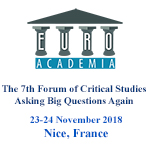Euroacademia Conferences
 Europe Inside-Out: Europe and Europeanness Exposed to Plural Observers (9th Edition) April 24 - 25, 2020
Europe Inside-Out: Europe and Europeanness Exposed to Plural Observers (9th Edition) April 24 - 25, 2020 Identities and Identifications: Politicized Uses of Collective Identities (9th Edition) June 12 - 13, 2020
Identities and Identifications: Politicized Uses of Collective Identities (9th Edition) June 12 - 13, 2020 8th Forum of Critical Studies: Asking Big Questions Again January 24 - 25, 2020
8th Forum of Critical Studies: Asking Big Questions Again January 24 - 25, 2020 Re-Inventing Eastern Europe (7th Edition) December 13 - 14, 2019
Re-Inventing Eastern Europe (7th Edition) December 13 - 14, 2019 The European Union and the Politicization of Europe (8th Edition) October 25 - 26, 2019
The European Union and the Politicization of Europe (8th Edition) October 25 - 26, 2019 Identities and Identifications: Politicized Uses of Collective Identities (8th Edition) June 28 - 29, 2019
Identities and Identifications: Politicized Uses of Collective Identities (8th Edition) June 28 - 29, 2019 The European Union and the Politicization of Europe (7th Edition) January 25 - 26, 2019
The European Union and the Politicization of Europe (7th Edition) January 25 - 26, 2019 7th Forum of Critical Studies: Asking Big Questions Again November 23 - 24, 2018
7th Forum of Critical Studies: Asking Big Questions Again November 23 - 24, 2018 Europe Inside-Out: Europe and Europeanness Exposed to Plural Observers (8th Edition) September 28 - 30, 2018
Europe Inside-Out: Europe and Europeanness Exposed to Plural Observers (8th Edition) September 28 - 30, 2018 Identities and Identifications: Politicized Uses of Collective Identities (7th Edition) June 14 - 15, 2018
Identities and Identifications: Politicized Uses of Collective Identities (7th Edition) June 14 - 15, 2018
#Got_no_other_xv_century_left_for_u”: The Negotiations of Belonging in the Communities of XV Century Reenactors in Russia
-
-

-
Presentation speakers
- Marina Baiduzh, Centre for Folklore Studies, School of Advanced Study for the Humanities, Russian Presidential Academy of National Economy and Public Administration, Moscow
Abstract:
“#got_no_other_xv_century_left_for_u” [rus. #ДругойПятнахиУнасДляВасНет] – this phrase appeared at the end of the Living history event “L`Ultima Frontiera Taurica 2016”. At that time, this phrase had a direct meaning – although everyone was tired, it was the only living history event in 2016 in the medieval re-enactment. In 2017 this hash tag became especially popular, but it acquired a new meaning. There were alternative events of this format and re-enactment direction, so it started to mean: “Our fifteenth century is the only correct one, and all alternatives are not worthy for existence”. So, the meme has become a marker of the internal boundaries of the community. This is due to the natural process of constructing the identity and authenticity of a local community or subculture, which is especially important for re-enactors’ movement. It happens as historical re-enactment has a principal prescription – to create some artifact or practice absolutely «authentic». However, this notion of «main rule» is variative enough. The following variative norms are the basis for diversity in the re-enactment movement such as functional differences (sport and fighter direction; living history movements) or local distinction (Moscow and surrounding places; Saint Petersburg; Siberia and Ural region). Despite the fact that the community of XV century re-enactors appeared in the early 2000s as an alternative to the sport direction, where the emphasis of living history is the scrupulously recreating all things, from a costume to a staff. The form of presentation of their historical research and experimentation is presented in a set of non-profit events made by “re-enactors for re-enactors”. In this regard, a halo of elitism of this community immediately emerged. It began look like a «private club». In the report we will focus on two questions: 1. Comparison of different communities within the society of XV century re-enactors in Russia («Renaissance Unity», «Ratobortsy», Saint Thomas Guild 1470-1480, community from Saint Petersburg and Siberia, etc.). It should be noted that such associations are not re-enactment “clubs” or other formal structures in their strict meaning. 2. Revealing the factors according to which there is a diversification, as well as the analysis of mythological models for constructing of the image of the Alien and the Other in the society of XV century re-enactors in Russia. The data of this research is collected from a number of cases – the living history events of the XV century re-enactors in 2016-2017. In addition, a participants’ observation was conducted, and a row of spontaneous and planned interviews were recorded. The main case for this report is the festival “Jäger” (17-23.08.2017, Karelia, Russian Federation). At this event the diversification in a team of 50 people during the week of residence in the forest was the most clearly realized. Moreover, online materials (posts, discussions, disputes, etc.) were used. Texts of participants in the observed communities are involved. So, the constant diversification and constructing a new inner limits – is the basic characteristic for the society of the XV century re-enactors in Russia. That is why these cases was analyzed with help of anthropological approach (by Victor Turner and its processual understanding of the community as a struggle between communitas and the structure) and structural-typological analysis of cultural and mythological models, in accordance with which the internal borders and the image of the Aliens are built.
-
Related Presentations













